The PICASO project ended 30 June 2019 and a final newsletter is now available. We also invite you to visit our Knowledge centre where you can watch the two PICASO videos: “Sharing care plans” and “Care efficiency, conflict identification and patient control”. In the Knowledge centre you will also find a list of all the public deliverables, newsletters, presentations, publications and the final PICASO brochure which highlights the project’s key achievements.
Integrated Care
The PICASO Clinician Dashboard enables clinicians to create and share care plans for patients with multiple conditions. Patient data can be shared across multi-actor care spaces via the PICASO Integrated Care Platform to support integrated care where multiple care services, interventions and care providers are joined together to deliver a more holistic care to patients. The Clinician Dashboard also provides interactive visualisation tools that allows care providers to see patient data from an integrated care perspective.
The images below are examples of how clinicians can view patient data in the Clinician Dashboard.
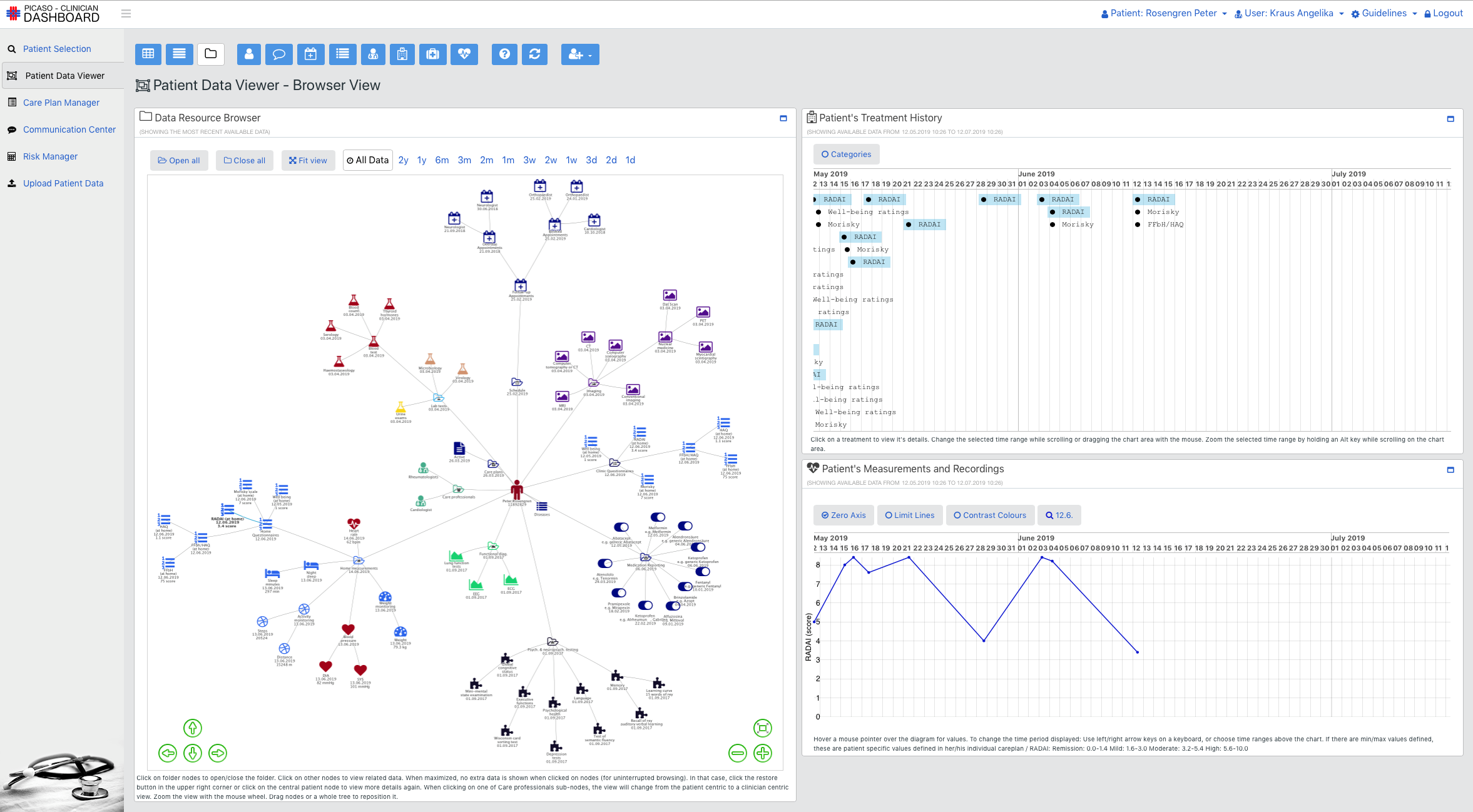
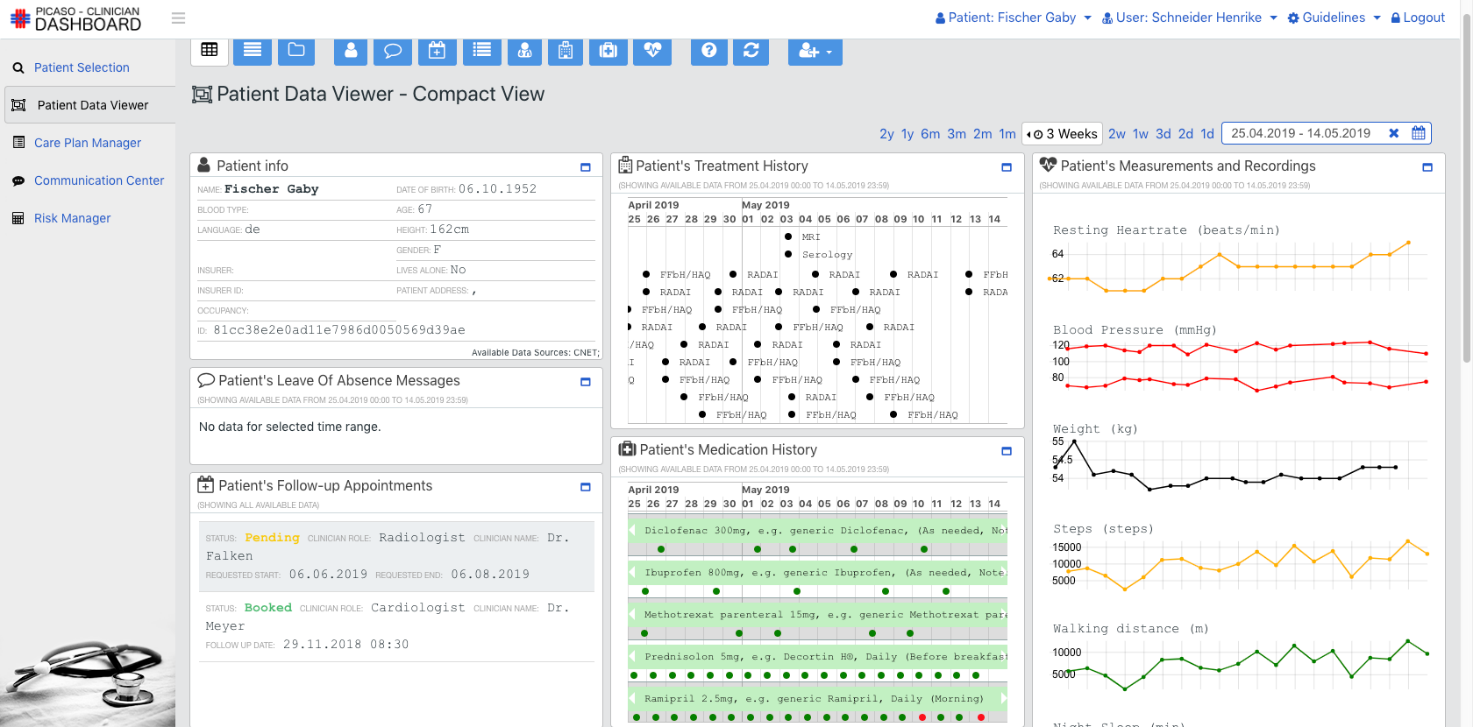
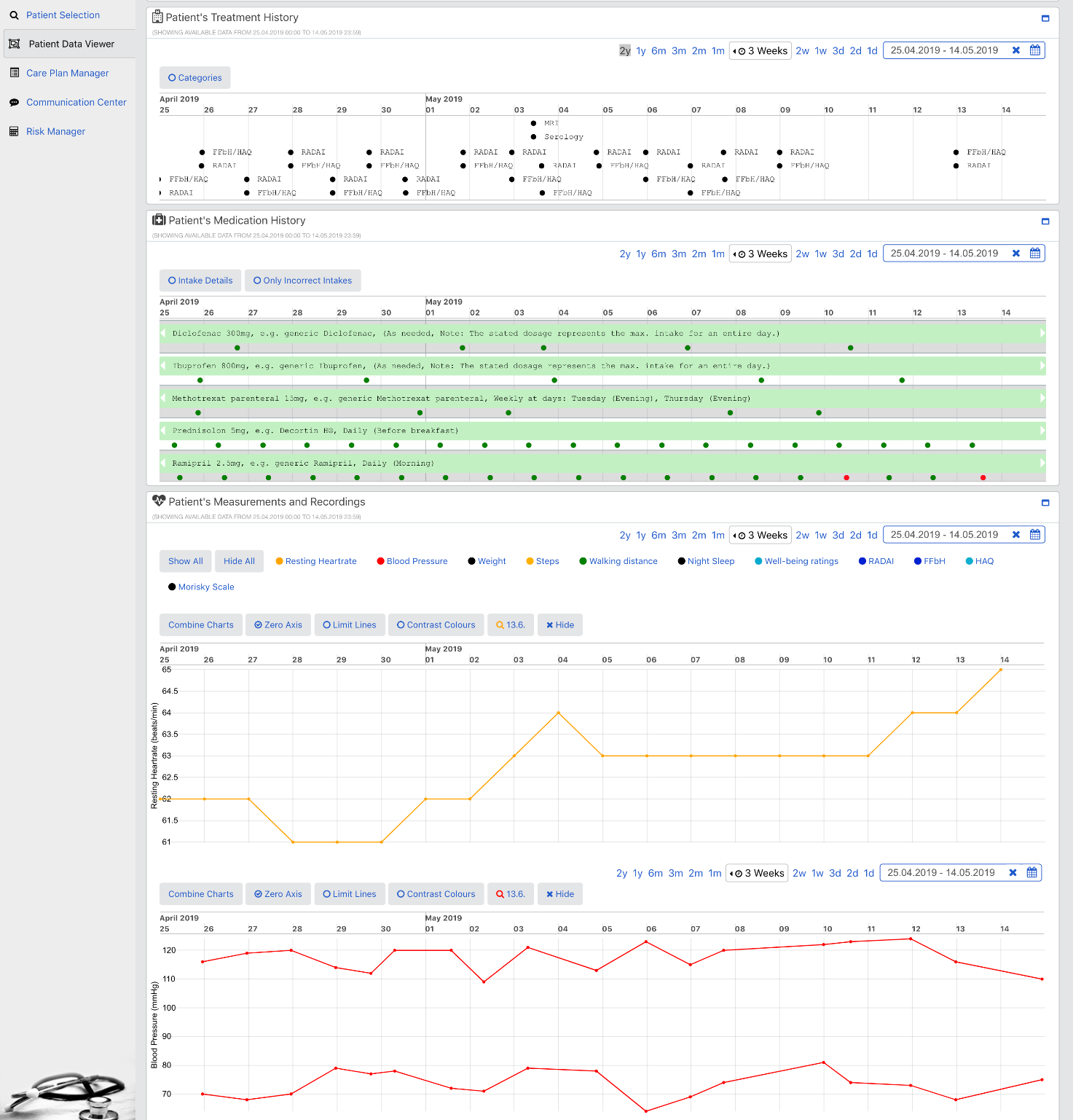
Patient care plans are dynamically adjusted each time a clinician adds or changes elements. Overlapping or conflicting elements in a patient’s care plan are captured and notified to the clinician complete with details of the origin of the conflict.
PICASO: A Secure Multiple Cloud Solution
The PICASO platform is an innovative cloud solution that facilitates interoperability across distributed data sources. It enables care organisations to benefit from cloud technologies and experience benefits of scalability and software resource sharing without violating regulations regarding clinical data. The cloud is divided into three loosely coupled node types. All software for care management and decision support is hosted in one public cloud while all clinical data resides inside the care organisations. All access and use of clinical data are done in a secure and authorised way in accordance with the General Data Protection Regulation (GDPR).
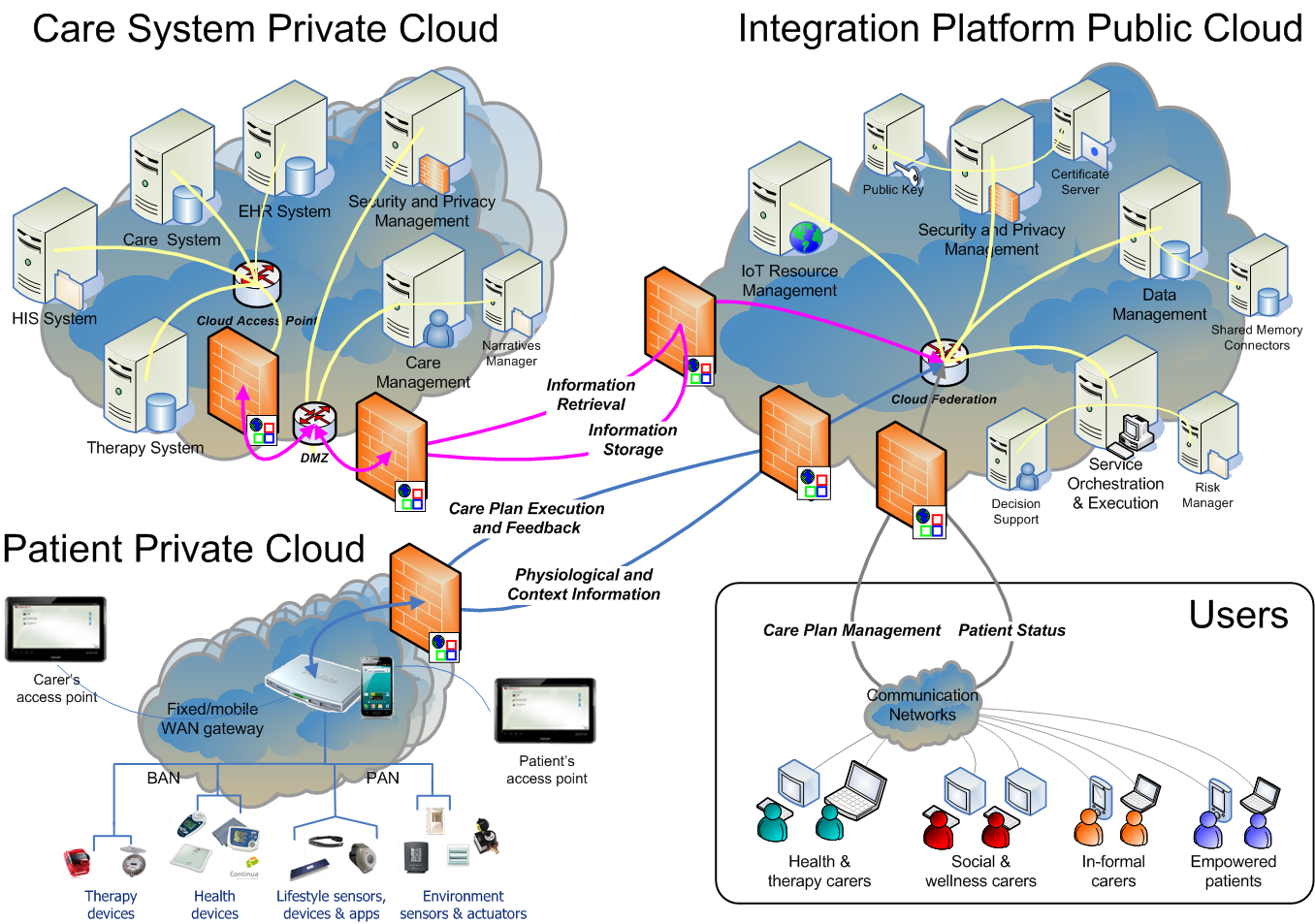
Patient Self-Monitoring
The Patient Self-Monitoring Solution is supported by the Patient Dashboard and the PICASO App. It is a self-monitoring platform that integrates three types of monitoring schemes – scheduled vital signs measurements with medical devices, continuous activity and behaviour monitoring using wearable sensors, and patient self-assessment using disease-specific clinical questionnaires. The Patient Self-Monitoring solution helps patients and clinicians to establish a complete view of the patient health status compared with existing solutions that support only one of these three monitoring schemes, usually limited to the time of a given consultation between patient and physician. The Clinician Dashboard allows clinicians to view the measurement the patients have taken at home and shared via the Patient Dashboard and the PICASO App. Also, the data that is collected automatically, e.g. activity, is accessible. The patient’s self-monitoring data can be viewed in different formats, e.g. separate or joined graphs, and for different time frames.
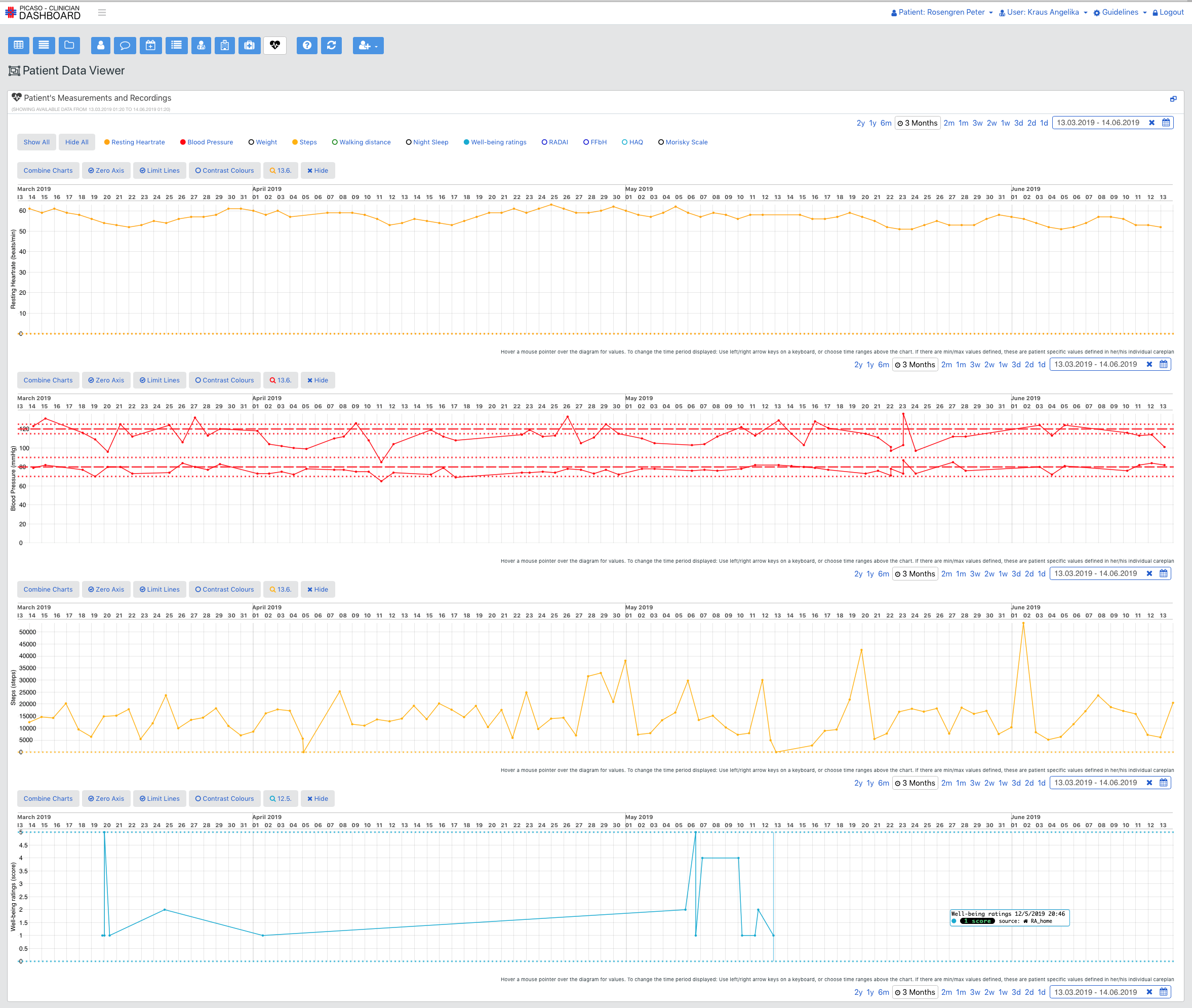
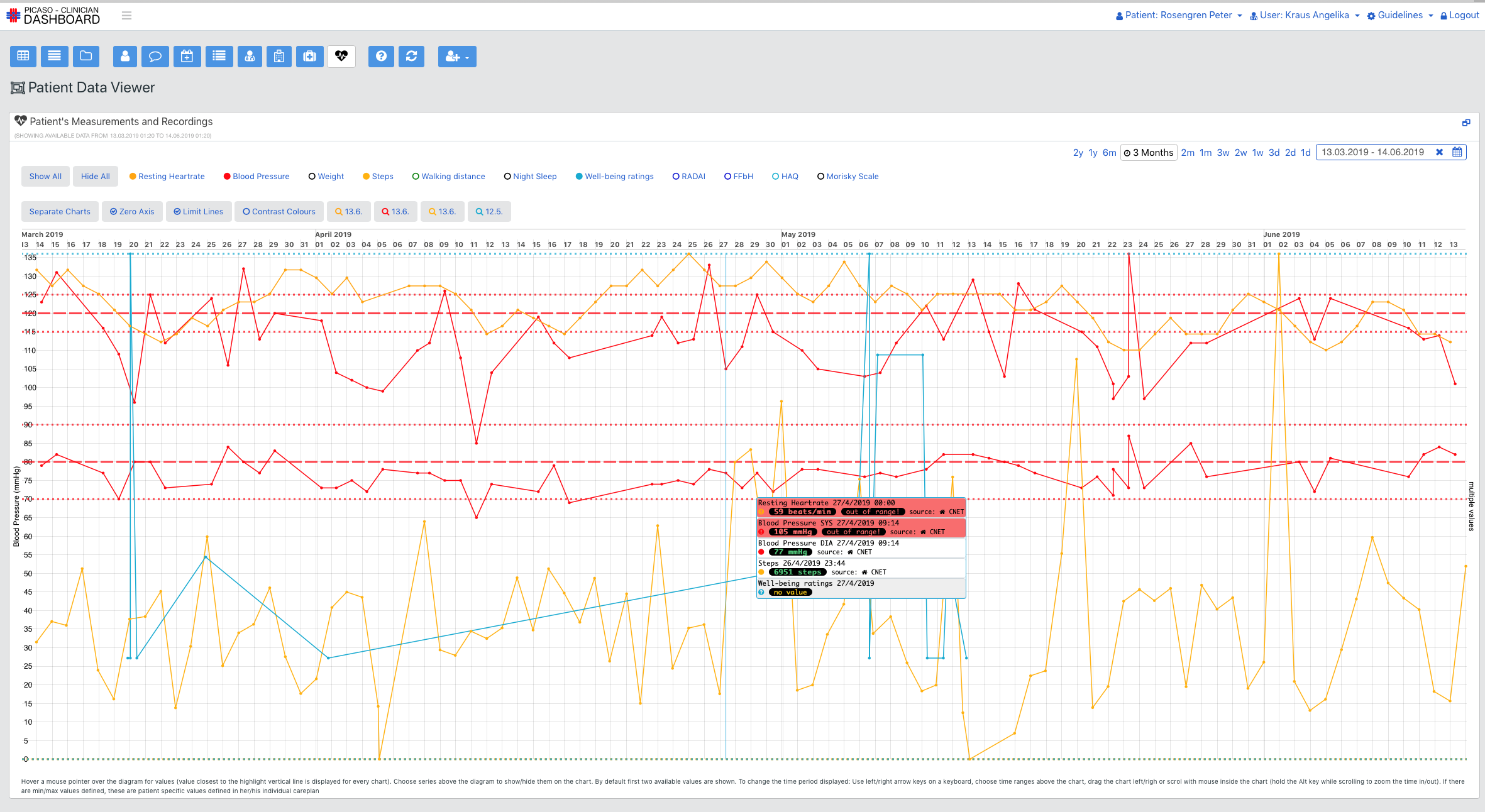
The Patient Dashboard is integrated with the patient’s care plan and allows patients to get daily overview of all the care related activities and tasks which is presented in a diary format. Patients can use the Patient Dashboard to confirm that they have taken their prescribed medication, the dosage and time of day and share this information with their clinicians and informal carers. In addition, it is possible for patients to document and attach a note explaining any deviances from their medication plan. This supports clinicians to evaluate the effect of the medication on the patient’s health, as well as patients, and their informal carers, to keep track of their medication intake. Patients can also record the intake of any other medication, such as pain medication, and include a note explaining why they have taken it. This type of information can be very useful for clinician and can help to optimise the treatment of the patient. Informal carers also benefit because they can follow the patient’s care plan, health status and care plan adherence remotely which may alleviate any anxiety they have felt before when they did not have access to this information. The many functionalities of the Patient Dashboard supports patient engagement, empowerment and care adherence.
Trial results
The clinicians involved in the two PICASO trials have been positive about the possibility to share patient data because it allowed them to better understand the patient’s health status. They see PICASO as a solid tool that can support integrated care because it allows all associated clinicians to work in, and share, one integrated patient care plan. The conflict functionality was particularly useful as was the possibility to use the tools to determine which elements of a patient’s care plan to view and how these elements should be presented. Additionally, clinicians found that the Care Plan Manager, a component in the Clinician Dashboard, could be used to provide more personalised care. Their interaction and communication with the patient were supported by the PICASO tools, e.g. by easily updating and monitoring patient’s care plan, writing personalised suspend messages, or personalised reminders.
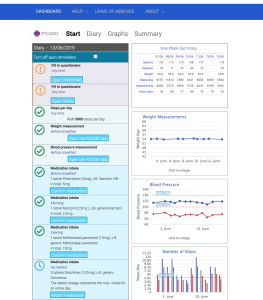
The results from the two trials have also shown that patients have welcomed the self-monitoring solution. They found that PICASO helped them getting a better insight into their condition and the health parameters that affect their daily lives. Patients felt that using PICASO enhanced their ability to manage their condition which would potentially improve their health. Their perception of self-efficacy was thus enhanced leading to greater patient empowerment.
From the clinician perspective, access to the self-monitored patient data was useful to get a deeper knowledge of the patient’s current health status as well as on the progress of their multimorbidities. Detailed clinical results from the trial are planned for publication in relevant medical journals. Information on the trial results will also be made available on the project website.
PICASO video – Care efficiency, conflict identification and patient control of data
Watch how the PICASO self-monitoring solution supports patient empowerment for patients with multimorbidities – in this case a woman suffering from rheumatoid arthritis and cardiovascular conditions. She is actively engaged by measuring health parameters at home and sharing this data with her physicians and informal caregivers, who can identify possible treatment overlap and optimise treatment.
A Market Analysis for the Future Exploitation of PICASO
The PICASO consortium has made a project market analysis paper available for download.
The paper presents an analysis of the European healthcare landscape with a detailed analysis four member states’ healthcare markets: Denmark, Germany, Italy and Sweden. The market analysis was carried out in connection with the EU project PICASO – A Personalised Integrated Care Platform. It was thus carried out based on confidential knowledge of the PICASO results and potential exploitation avenues for project partners.
The domain of healthcare is a policy area strongly in the hands of the individual EU Member States, and as the European population is growing older, healthcare services face massive challenges. The political realm forces us to treat the European healthcare landscape in terms of each country’s individual structure, opportunities and market attractiveness.
In order to focus the market analysis on the PICASO project’s visions and results, the three most relevant segmentation variables was first identified: i) e-readiness level (acceptance of the use of ICT solutions in healthcare), ii) fragmentation (the number and nature of care players in a given geographical area), and iii) the relevance to PICASO partners (focusing on partner countries).
Download the paper: A Market Analysis for the Future Exploitation of PICASO
PICASO Video – Sharing Care Plans
Watch our newly released video about the sharing of care plans between professional caregivers across care sectors, using the PICASO data platform. The video focuses on the clinician perspective and how the sharing of patient data optimises the treatment and management of patients with Parkinson’s Disease at The Faculty of Medicine at the University of Rome Tor Vergata.
Watch the PICASO Videos
Two project videos based on the experiences and results of the two PICASO trials have been produced. The videos demonstrate how PICASO supports integrated care and helps to identify constraints and conflicts when caring for patients with multimorbidities.
The first video focuses on the clinician perspective and how the sharing of patient data optimises the treatment and management of patients with Parkinson’s Disease. The second video focuses on the patient self-monitoring solution for patients with rheumatoid arthritis and how it supports patient empowerment.
PICASO article in the European Journal of Nuclear Medicine and Molecular Imaging
PICASO partner, UTV, who has run the trial in Italy, has successfully submitted an article for publication in the European Journal of Nuclear Medicine and Molecular Imaging. The article, ‘Brain metabolic patterns in patients with Suspected non-Alzheimer’s pathophysiology (SNAP) and Alzheimer’s disease (AD): is [18F] FDG a specific biomarker in these patients?’, is based on a study where medical data was shared using PICASO.
The article can be downloaded here.
Abstract
Aim: The present study was aimed to compare the pattern of the brain [18F] FDG uptake in Suspected non-Alzheimer’s pathophysiology (SNAP), AD and healthy controls by using 2-Deoxy-2-[18F]fluoroglucose ([18F] FDG) Positron Emission Tomography imaging. Cerebrospinal fluid (CSF) biomarkers amyloid-β1–42 peptide (Aβ1–42) and Tau were used in order to differentiate AD from SNAP.
Materials and methods: the study included 43 newly-diagnosed AD patients (female=23; male=20) according to the NINCDS-ADRDA criteria and 15 SNAP patients (female=12; male =3) and a group of 34 healthy subjects that served as the control group (CG) found to be normal at neurological evaluation (males=20; females=14). A neuropsychological battery was administrated in AD and SNAP subjects; cerebrospinal fluid assay was conducted in both AD and SNAP as well. Brain PET/CT acquisition was started 30 ± 5 min after [18F] FDG injection in all the subjects. Statistical parametric mapping 12 (SPM12) implemented in Matlab 2018a was used for the analysis of PET scans in this study.
Results: As compared to SNAP, AD subjects showed a significant hypometabolism in a wide cortical area that involves the right frontal, parietal and temporal lobes. As compared to CG, AD subjects showed a significant reduction of [18F] FDG uptake in the parietal, limbic and frontal cortex while a more limited reduction of [18F] FDG uptake in the same areas was obtained when comparing SNAP to CG.
Conclusions: SNAP subjects show a milder impairment of brain [18F] FDG uptake as compared to AD. The partial overlap of the metabolic pattern between SNAP and AD limits the use of [18F] FDG PET/CT in effectively discriminating these clinical entities.
Download the article.
